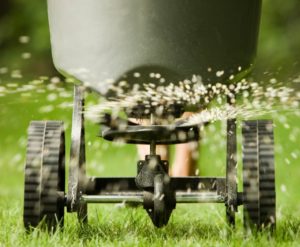Aeration removes small cores of soil and thatch to allow oxygen, water, and fertilizer to penetrate down to the root zone. The cores brought to the surface contain microorganisms, which help the breakdown of the woody thatch tissue. This allows the roots of existing grass plants to spread out and grow deeper, creating a healthier, thicker lawn. Loosening the compacted soil stimulates root growth and will reduce costly water run-off by up to 50%.
Most experts agree that lawns need aerating at least once a year. Some lawns require aeration more often due to the type of soil and amount of traffic on the lawn. A good time to aerate is early spring and or fall.
Immediately following aeration is also an excellent time to apply grass seed to fill in thin areas and to thicken the entire lawn.

Over-Seeding
Over-seeding is sometimes necessary for lawns with grass types such as Bluegrass, Fescue, and Ryegrass. Cool-season grasses are clump-type grasses. Therefore, when they thin out due to insects, disease, or summer heat, they need to be reseeded in order to reestablish a thick lawn.
Warm-season turfs such as Zoysia rarely need overseeding, but we do recommend aeration to help promote the spreading of these types of grass. Seeding is best done in early to mid-fall.